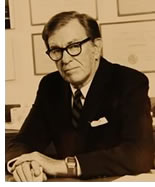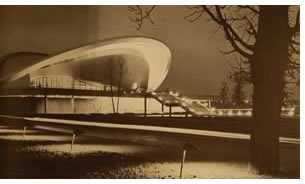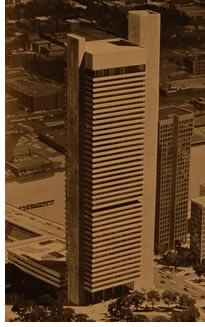

7/2006

 Hugh Stubbins, FAIA, an icon of
American Modernism, died July 5 in Cambridge, Mass.
Hugh Stubbins, FAIA, an icon of
American Modernism, died July 5 in Cambridge, Mass.
“Mr. Stubbins was one of the great masters of our profession in
the latter half of the twentieth century,” said Stubbins Associates
President and CEO Scott Simpson, FAIA. “He pioneered bold forms
(the parabolic roof at the Berlin Congress Hall), innovative structural
systems (Citicorp), unique use of materials (the aluminum skin panels
at the Federal Reserve Bank), new technologies (the tuned mass damper),
interesting juxtapositions of Modern and traditional symbolism in architecture
(Mitsubishi Estates in Japan), and great versatility in style (from Modern
houses in the ’50s to Fifth Avenue Place in Pittsburgh to the Ronald
Reagan Presidential Library). His buildings, each unique to its context,
program, and clients, told a story, reflecting  the
aspirations of our times. He was a teacher, writer, practitioner, artist,
and successful in business—a true Renaissance man. He was an inspiration
to many and will forever be remembered as one of the lions of our profession.
the
aspirations of our times. He was a teacher, writer, practitioner, artist,
and successful in business—a true Renaissance man. He was an inspiration
to many and will forever be remembered as one of the lions of our profession.
“All of us at Stubbins owe him a great debt. He not only founded the firm, he created its ‘DNA,’ which is based on doing great work for great clients. He set the bar very high, leaving us all something to strive for. We are fortunate indeed to be beneficiaries of his tremendous legacy.”
 Born
in Birmingham in 1912, Stubbins graduated from the Georgia Institute
of Technology in 1933 and the Harvard Graduate School of Design in 1935.
He subsequently served on the faculty at Harvard for 13 years, working
as assistant to Walter Gropius, whom he replaced as the architecture
department chair in 1953.
Born
in Birmingham in 1912, Stubbins graduated from the Georgia Institute
of Technology in 1933 and the Harvard Graduate School of Design in 1935.
He subsequently served on the faculty at Harvard for 13 years, working
as assistant to Walter Gropius, whom he replaced as the architecture
department chair in 1953.
Stubbins left Harvard in 1954, prompting critic Louis Mumford to comment that the “architectural profession lost one of its best teachers when Hugh Stubbins began to devote his total efforts to practice,” recalls 1991–’92 AIA Secretary Douglas Engebretson, FAIA.
He was chosen by a special committee of the AIA to design the Congress
Hall in West Berlin in 1955. He achieved AIA Fellowship in 1960 and was
an AIA national vice president in 1964 and ’65. His firm, which
he founded in 1949, became the fourth AIA Firm Award recipient in 1967 “for
its consistent work of highest quality, both in design and in detailed
execution,” reads the  citation. “Its awareness of human needs
in schools and homes, and its sensitive respect for environment and tradition,
are inspiring to student and public alike.”
citation. “Its awareness of human needs
in schools and homes, and its sensitive respect for environment and tradition,
are inspiring to student and public alike.”
Perhaps the architect’s most noted architectural achievement came in 1978 with the AIA Honor Award-winning Citicorp Center, renowned both for its canted top and its open ground-level plaza created by the building standing on four massive columns. “While Stubbins has never pursued innovation for its own sake,” stated a Hugh Stubbins and Associates press release at the time, “he does believe in exploiting the leading edge of technology to fulfill the practical and aesthetic needs of human beings.”
Copyright 2006 The American Institute of Architects.
All rights reserved. Home Page ![]()
![]()
![]()